| year by year |
1953 - 1962
First generation Corvette...


|
1963 - 1967
Second generation Corvette...


|
1968 - 1982
Third generation Corvette...


|
1984 - 1996
Fourth generation Corvette...


|
1997 - 2004
Fifth generation Corvette...


|
2005 - Present
Sixth generation Corvette...


|
Future
Seventh generation Corvette...


|
 |
|
| |
1963 Corvette
|
Corvette's designers and engineers -- Ed Cole, Zora Arkus-Duntov, Bill Mitchell and others -- knew that after 10 years in its basic form, albeit much improved, it was time to move on. By decade's end, the machinery would be put into motion to fashion a fitting successor to debut for the 1963 model year. After years of tinkering with the basic package, Bill Mitchell and his crew would finally break the mold of Earl's original design once and for all. He would dub the Corvette’s second generation "Sting Ray" after the earlier race car of the same name (but now spelled out in separate words).
The independent rear suspension Duntov created for Sting Ray was simple yet effective. It was essentially a frame-mounted differential with U-jointed half-shafts tied together by a transverse leaf spring -- a design derived from the CERV I concept. Rubber-cushioned struts carried the differential, which reduced ride harshness while improving tire adhesion, especially on rougher roads. The transverse spring was bolted to the rear of the differential case. A control arm extended laterally and slightly forward from each side of the case to a hub carrier, with a trailing radius rod mounted behind it. The half-shafts functioned like upper control arms. The lower arms controlled vertical wheel motion, while the trailing rods took care of fore/aft wheel motion and transferred braking torque to the frame. Shock absorbers were conventional twin-tube units.
Considerably lighter than the old solid axle, the new rear suspension array delivered a significant reduction in unsprung weight, which was important since the 1963 model would retain the previous generation's outboard rear brakes.
The new model's front suspension would be much as before, with unequal-length upper and lower A-arms on coil springs concentric with the shocks, plus a standard anti-roll bar. Steering remained the conventional recirculating-ball design, but it was geared at a higher 19.6:1 overall ratio (previously 21.0:1). Bolted to the frame rail at one end and to the relay rod at the other was a new hydraulic steering damper (essentially a shock absorber), which helped soak up bumps before they reached the steering wheel. What's more, hydraulically assisted steering would be offered as optional equipment for the first time on a Corvette -- except on cars with the two most powerful engines -- and offer a faster 17.1:1 ratio, which reduced lock-to-lock turns from 3.4 to just 2.9.
|
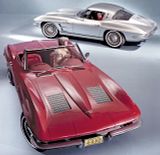
The 1963 Corvette Sting Ray debuted with a trimmer 98-inch
wheelbase and first-time all-independent suspension.

The 1963 Corvette Sting Ray coupe boasted a distinctive split rear window.


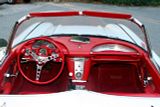
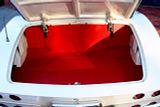
|
1963 Corvette Design Features
While Duntov was developing an innovative new chassis for the 1963 Corvette, designers were adapting and refining the basic look of the racing Stingray for the production model. A fully functional space buck (a wooden mock-up created to work out interior dimensions) was completed by early 1960, production coupe styling was locked up for the most part by April, and the interior -- instrument panel included -- was in place by November. Only in the fall of 1960 did the designers turn their creative attention to a new version of the traditional Corvette convertible and, still later, its detachable hardtop.
For one the first time in the Corvette's history, wind tunnel testing helped refine the final shape, as did practical matters like interior space, windshield curvatures, and tooling limitations. Both body styles were extensively evaluated as production-ready 3/8-scale models at the Cal Tech wind tunnel.
The vehicle's inner structure received as much attention as its exterior aerodynamics. Fiberglass outer panels were retained, but the Sting Ray emerged with nearly twice as much steel support in its central structure as the 1958-62 Corvette. The resulting extra weight was balanced by a reduction in fiberglass thickness, so the finished product actually weighed a bit less than the old roadster. Passenger room was as good as before despite the tighter wheelbase, and the reinforcing steel girder made the cockpit both stronger and safer.
Symbolic of the car's transformation was the first-ever production Corvette coupe -- a futuristic fastback that sported one of the most unique styling elements in automotive history -- a divided rear window. This feature had once been considered for an all-new 1958 Corvette, and Mitchell thought enough of the backlight backbone to resurrect it for the 1963 redesign. The rear window's basic shape, which was a compound-curve "saddleback," had been originally conceived by Bob McLean for the Q-model.
The rest of the Sting Ray design was equally stunning. Quad headlamps were retained but newly hidden -- the first American car so equipped since the 1942 DeSoto. The lamps were mounted in rotating sections that matched the pointy front end with the "eyes" closed. An attractive beltline dip was added at the door's trailing upper edge, a result of cinching up the racing Stingray at the midriff. Coupe doors were cut into the roof, which made entry/exit easier in such a low-slung closed car. Faux vents were located in the hood and on the coupe's rear pillars; functional ones had been intended but were nixed by cost considerations.
The Sting Ray's interior carried a new interpretation of the twin-cowl Corvette dash motif used since 1958, with the scooped-out semicircles now standing upright instead of lying down. It was also more practical, now incorporating a roomy glovebox, an improved heater, and the cowl-ventilation system. Also on hand was a full set of easy-to-read round gauges that included a huge speedometer and tachometer. The control tower center console returned, somewhat slimmer but now containing the clock and a vertically situated radio with a dial oriented to suit.
Luggage space was improved as well, though due to a lack of an external trunklid, cargo had to be stuffed behind the seats. If you wanted to carry anything other than passengers in the convertible, you also had to disconnect the folded top from its flip-up tonneau panel. The spare tire was located at the rear in a drop-down fiberglass housing beneath the gas tank (which now held 20 gallons instead of 16). The big, round deck emblem was newly hinged to double as a fuel-filler flap, replacing the previous left-flank door.
Though not as obvious as the car's radical styling, the new chassis was just as important to the Sting Ray's success. Maneuverability was improved thanks to the faster "Ball-Race" steering and shorter wheelbase. The latter might ordinarily imply a choppier ride, but the altered weight distribution partly compensated for it. Less weight on the front wheels also meant easier steering, and with some 80 additional pounds on the rear wheels, the Sting Ray offered improved traction.
Stopping power improved, too. Four-wheel cast-iron 11-inch drum brakes remained standard but were now wider, for an increase in effective braking area. Sintered-metallic linings, segmented for cooling, were again optional. So were finned aluminum ("Al-Fin") drums, which not only provided faster heat dissipation (and thus better fade resistance) but less unsprung weight. Power assist was available with both brake packages. Evolutionary engineering changes included positive crankcase ventilation, a smaller flywheel, and an aluminum clutch housing. A more efficient alternator replaced the old-fashioned generator.
Drivetrains were carried over from the previous model, comprising four 327 V-8s, a trio of transmissions, and six axle ratios. Carbureted engines came in 250-, 300-, and 340-horsepower versions. As before, the base and step-up units employed hydraulic lifters, a mild cam, forged-steel crankshaft, 10.5:1 compression, single-point distributor, and dual exhausts. The 300-bhp engine produced its extra power via a larger four-barrel carburetor (Carter AFB instead of the 250's Carter WCFB), plus larger intake valves and exhaust manifold. Again topping the performance chart was a 360-bhp fuel-injected powerhouse, available for an extra $430.40.
The car's standard transmission remained the familiar three-speed manual, though the preferred gearbox continued to be the $188.30 Borg-Warner manual four-speed, delivered with wide-ratio gears when teamed with the base and 300-bhp engines, and close-ratio gearing with the top two powerplants. Standard axle ratio for the three-speed manual or Powerglide was 3.36:1. The four-speed gearbox came with a 3.70:1 final drive, but 3.08:1, 3.55:1, 4.11:1, and 4.56:1 gearsets were available. The last was quite rare in production, however.
|

For 1963, Corvette offered the first-ever Corvette coupe.
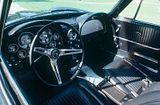
The redesigned 1963 Corvette Sting Ray featured a more user-friendly dash configuration.
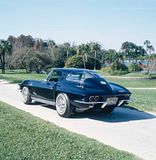
The 1963 Corvette Sting Ray coupe boasted a distinctive split rear window.
|
1963 Corvette Manufacturing and Marketing
The 1963 Corvette Sting Ray was an instant sensation and a certifiable blockbuster. "Only a man with a heart of stone could withstand temptation like this," the inaugural Sting Ray ad copy read. It would prove to be prophetic. Corvette sales would skyrocket to heights never imagined. The St. Louis factory where the Corvette was assembled would add a second shift, yet still couldn't keep up with demand. Customers were forced to wait up to two months for delivery -- and to pay full retail price for the privilege. Even so, the Sting Ray maintained tradition by offering remarkable sports-car value for the money. Base price was $4,037 for the convertible and $4,257 for the split-window coupe.
What's more, used-car values for previous years' models began heading upward, making this one of the first postwar cars to surpass its original list price on the collectors' market. Today the Sting Ray generation stands as perhaps the most desirable Corvette of all -- the 1963 split-window coupe in particular.
The Sting Ray was lauded in the automotive press almost unanimously for its handling, road adhesion, and sheer explosive power. Car Life bestowed its annual Award for Engineering Excellence on the 1963 Sting Ray. Chevy's small-block V-8 -- the most consistent component of past Corvette performance -- was rated by the buff books to be even better in the Sting Ray. The 1963 was noted to have an edge over past models in both traction and handling because the new independent rear suspension reduced wheelspin compared to the live-axle cars. Testing a four-speed fuelie with 3.70:1 axle, Motor Trend reported 0-30/45/60 mph in 2.9/4.2/5.8 seconds and a 14.5-second standing quarter-mile at 102 mph. The magazine also recorded better than 18 miles per gallon at legal highway speeds and 14.1 mpg overall.
The Sting Ray was a notch above even the best European sports cars with its contoured bucket seats, telescopic steering wheel adjustment, functional instrumentation, and a heating/ventilation system fully able to cope with the greater extremes of the North American climate. True, the steering column adjustment demanded a little wrench work. And yes, the seats were a little low for some, though that was because Duntov wanted them that way for a low center of gravity. But overall, the Sting Ray was the most civilized Corvette ever and one of the most refined sporting cars built anywhere on the planet. Buyers now even had the option of ordering the car with leather upholstery and air conditioning.
Chevrolet's advertising for 1963 made the most of the Corvette's improved accommodations with a pair of ads. One headline offered, "Power brakes, power windows, power steering, air conditioning, automatic transmission ... why do they call this a sports car?" The second reversed the same basic theme with, "Looks like a sports car, feels like a sports car, performs like a sports car, how come it's a luxury car?"
An astounding 21,513 units would be built for the 1963 model year, which was up 50 percent from the record-setting 1962 version. Production was divided almost evenly between the convertible and the new coupe -- 10,919 and 10,594, respectively -- and more than half the convertibles were ordered with the optional lift-off hardtop. Nevertheless, the coupe wouldn't sell as well again throughout the Sting Ray years. In fact, not until 1969 (by which time the coupe came with removable T-tops) did the closed Corvette sell better than the open one.
Equipment installations for 1963 began reflecting the market's demand for more civility in sporting cars. For example, the power brake option went into 15 percent of production, power steering into 12 percent. On the other hand, only 278 buyers specified the $421.80 air conditioning; leather upholstery -- a mere $80.70 -- was ordered on only about 400 cars. The beautiful cast aluminum knock-off wheels, manufactured for Chevy by Kelsey-Hayes, cost $322.80 a set, but few buyers checked off that option. However, almost 18,000 Sting Rays left St. Louis with the four-speed manual gearbox -- better than four out of every five.
|
|
The Development of the Sting Ray
The production Sting Ray's lineage can be traced to two separate GM projects: the Q-Corvette, and perhaps more directly, Mitchell's racing Stingray.
The Q-Corvette, initiated in 1957, envisioned a smaller, more advanced Corvette as a coupe-only model, boasting a rear transaxle, independent rear suspension, and four-wheel disc brakes, with the rear brakes mounted inboard. Exterior styling was purposeful, with peaked fenders, a long nose, and a short, bobbed tail. The car was originally envisioned as one of a full line of large rear-transmission cars with which the Q-Corvette would share major components. But the passenger-car line was scrapped as being too radical, and the Corvette variant suffered the same fate.
Meanwhile, Zora Arkus-Duntov and other GM engineers had become fascinated with mid- and rear-engine designs. It was during the Corvair's development that Duntov took the mid/rear-engine layout to its limits in the CERV I concept. The Chevrolet Experimental Research Vehicle was a lightweight, open-wheel single-seat racer. A rear-engined Corvette was briefly considered during 1958-60, progressing as far as a full-scale mock-up designed around the Corvair's entire rear-mounted power package, including its complicated air-cooled flat-six as an alternative to the Corvette's usual water-cooled V-8.
By the fall of 1959, elements of the Q-Corvette and the Stingray Special racer would be incorporated into experimental project XP-720, which was the design program that led directly to the production 1963 Corvette Sting Ray. The XP-720 sought to deliver improved passenger accommodation, more luggage space, and superior ride and handling over previous Corvettes.
|
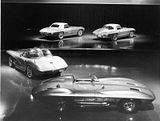
This "design heritage" photo was released to herald the 1963 Corvette
Sting Ray. The Stingray racer and 1960 XP-700 show car front the new convertible and fastback. |
1963 Corvette Specifications
The 1963 Corvette Sting Ray not only had a fantastic new design, but also newfound handling prowess. The Sting Ray was also a somewhat lighter Corvette, so acceleration improved despite unchanged horsepower. Here are the specifications for the 1963 Corvette Sting Ray:
Vehicle Specifications
|
Convertible
|
Coupe |
Wheelbase, inches
|
98.0
|
98.0 |
Length, inches
|
175.3
|
175.3 |
Width, inches
|
69.6
|
69.6 |
Track, inches
|
front: 56.3 rear 57.0
|
front: 56.3 rear: 57.0 |
Height, inches
|
49.8
|
NA |
Curb weight, pounds
|
3,150
|
3,150 |
Mechanical Specifications (2-door convertible/coupe)
Suspension
front:Independent; upper and lower A-arms, coil springs, antiroll bar, tubular hydraulic shock absorbers
rear: Fixed differential, U-jointed half shafts, lateral struts, radius rods, transverse leaf spring, tubular hydraulic shock absorbers, antiroll bar w/big block engines
Wheels/Tires
6.70x15
Brakes
front: 11-inch drum
rear: 11-inch drum
Transmission
3-speed manual (std)
4-speed manual (opt)
2-speed Powerglide (opt)
Standard axle ratio
3.70:1
Engine Specifications
| Type |
ohv V-8 |
ohv V-8 |
ohv V-8 |
ohv V-8 |
| Displacement, liters/cu inch |
5.35/327
|
5.35/327 |
5.35/327 |
5.35/327 |
| Bore x stroke, inches |
4.00 x 3.25 |
4.00 x 3.25 |
4.00 x 3.25 |
4.00 x 3.25 |
| Fuel Management |
1 x 4-bbl. |
1 x 4-bbl. (AFB)
|
1 x 4-bbl. (AFB)
|
fuel injection
|
| Horsepower @ rpm |
250 @ 4400 |
300 @ 5000 |
340 @ 6000 |
360 @ 6000 |
| Torque @ rpm, pound-foot |
350 @ 2800 |
360 @ 3200 |
344 @ 4000 |
352 @ 4000 |
Published Performance Numbers
Acceleration
|
300 hp, 4-sp man. |
0-60 mph, sec
|
6.1 |
0-100 mph, sec
|
14.5 |
1/4-mile, sec @ mph
|
14.5 @ 100 |
Vehicle Production and Base Prices
Car Type
|
Production
|
Price |
2-door convertible
|
10,919
|
$4,037.00 |
2-door coupe
|
10,594
|
4,252.00 |
Options and Production
Option
|
Production
|
Price |
Leather Seats
|
1,114
|
$80.70 |
Sebring Silver Exterior Paint
|
3,516
|
80.70 |
Soft Ray Tinted Glass, all
|
629
|
16.15 |
Soft Ray Tinted Glass, windshield
|
470
|
10.80 |
| Power Windows |
3,742
|
59.20 |
Auxiliary Hardtop
|
5,739
|
236.75 |
Heater and Defroster Delete (credit)
|
124
|
100.00 |
Air Conditioning
|
278
|
421.80 |
Positraction Rear Axle, all ratios
|
17,554
|
43.05 |
Highway Rear Axle, 3.08:1
|
211
|
2.20 |
Power Brakes
|
3,336
|
43.05 |
Sintered Metallic Brakes
|
5,310
|
37.70 |
300 hp Engine
|
8,033
|
53.80 |
340 hp Engine
|
6,978
|
107.60 |
360 hp Engine FI
|
2,610
|
430.40 |
| 4-speed Manual Transmission |
17,973
|
188.30 |
Powerglide Automatic Transmission
|
2,621
|
199.10 |
36 Gallon Fuel Tank (coupe)
|
63
|
202.30 |
Off Road Exhaust System
|
NA
|
37.70 |
Woodgrained Steering Wheel
|
3,063
|
16.15 |
Cast Aluminum Knock-Off Wheels
|
NA
|
322.80 |
Blackwall Tires, 6.70 x 15 nylon
|
412
|
15.70 |
| Whitewall Tires, 6.70 x 15 |
19,383
|
31.55 |
Back Up Lamps
|
318
|
10.80 |
AM Radio, signal seeking
|
11,368
|
137.75 |
AM/FM Radio
|
9,178
|
174.35 |
Special Performance Equipment
|
199
|
1,818.45 |
Color Choices and Production
Color Choice
|
Production |
Color Choice
|
Production |
| Tuxedo Black |
NA
|
Silver Blue
|
NA |
Daytona Blue
|
3,475
|
Riverside Red
|
4,612 |
Saddle Tan
|
NA
|
Ermine White
|
NA |
Sebring Silver
|
3,516
|
|
|
|
|
|
|